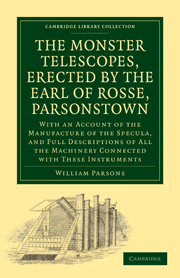 The Monster Telescopes, Erected by the Earl of Rosse, Parsonstown
The Monster Telescopes, Erected by the Earl of Rosse, Parsonstown PART II - The Manufacture of the Six Foot Speculum, and the Machinery of the “Monster” Telescope
Published online by Cambridge University Press: 01 March 2011
Summary
In the account of the three-foot Speculum which Lord Rosse published in the Philosophical Transactions for 1840, he speaks of the possibility of one six feet in diameter being cast. It might at that time have been considered as little less than a chimera by those who were not sufficiently acquainted with the experiments that had been made in his Lordship's laboratory, and there were not wanting some who denied altogether the practicability of the design. Various reasons were given why the attempt should be a failure, and many calculations entered into to prove the little benefit to be derived even supposing a perfect casting were obtained—But fortunately others thought differently; the idea had no sooner occurred to Lord Rosse than he determined to put it to the test, and we may say, without flattery, that no absurdity was likely to occupy a mind like his. The attempt has been made, and the result is perfect success.
As yet we cannot say how far it may advance our knowledge of the celestial spheres, or help us to understand more fully the mechanism of the universe; but this at all events is certain, that be the advantage great or small, it is the last step that can be taken to enlarge our acquaintance with those distant bodies, and all that is ever likely to be brought before us will now be seen.
- Type
- Chapter
- Information
- The Monster Telescopes, Erected by the Earl of Rosse, ParsonstownWith an Account of the Manufacture of the Specula, and Full Descriptions of All the Machinery Connected with These Instruments, pp. 31 - 54Publisher: Cambridge University PressPrint publication year: 2010First published in: 1844


